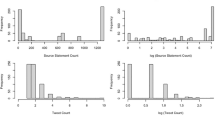Abstract
The number of client share assessments on Twitter is an important stage for checking and perusing public sentiment. Such checking and review can offer data for choice making in different areas. In these canvases, we move further to translate estimation variants for machine learning algorithms. In trendy, the chaotic variable has unique characters, and firstly chaotic Levy flight is included in the proposed meta-heuristic for successfully delivering new arrangements. Secondly, the psychology version of feeling and confused grouping presented stream acknowledgment choice in the cuckoo search algorithm. Furthermore, we propose an LDA model and Modified Latent Dirichlet Allocation (M-LDA). These M-LDA subjects pick most advisor tweets for changed topics and build up a new setup known as the Emotional Chaotic Cuckoo Search LDA model. The proposed obligations, including discovering point, contrast among two arrangements of documents.





Similar content being viewed by others
Change history
10 October 2022
This article has been retracted. Please see the Retraction Notice for more detail: https://doi.org/10.1007/s10772-022-10006-9
References
Agarwal, A., Xie, B., Vovsha, I., Rambow, O., & Passonneau, R. (2011). Sentiment analysis of Twitter data. In Proceedings of the ACL 2011 workshop on languages in social media (pp. 30–38).
Assi, C. M., Ye, Y., & Dixit, S. (2014). Dynamic bandwidth allocation for quality-of-service over ethernet PONs. IEEE Journal on Selected Areas in Communication, 21(9), 1467–1477.
Badia, L., Merlin, S., & Zorzi, M. (2008). Resource management in IEEE 802.11 multiple access networks with price-based service provisioning. IEEE Transactions on Wireless Communications, 7(11), 4331–4340.
Becker, H., Naaman, M., & Gravano, L. (2010). Learning similarity metrics for event identification in social media. In Proceedings of the third ACM WSDM, New York City.
Blei, D. M., Ng, A. Y., & Jordan, M. I. (2003). Latent Dirichlet allocation. The Journal of Machine Learning Research, 3, 993–1022.
Bollen, J., Mao, H., & Zeng, X. (2011). Twitter mood predicts the stock market. Journal of Computational Science, 2(1), 1–8.
Go, A., Bhayani, R., & Huang, L. (2009). Twitter sentiment classification using distant supervision. Technical Paper. Stanford University.
Griffiths, T. L., & Steyvers, M. (2004). Finding scientific topics. Proceedings of the National Academy of Sciences of the United States of America, 101(Suppl 1), 5228–5235.
Heinrich, G. (2009). Parameter estimation for text analysis. Technical report. Fraunhofer IGD and University of Leipzig, Germany.
Hu, M., & Liu, B. (2004). Mining and summarizing customer reviews. In Proceedings of the tenth ACM SIGKDD, Seattle, WA.
Jiang, L., Yu, M., Zhou, M., Liu, X., & Zhao, T. (2011). Target dependent Twitter sentiment classification. In Proceedings of the 49th annual meeting of the Association for Computational Linguistics. Portland, OR: Human Language Technologies.
Leskovec, J., Backstrom, L., & Kleinberg, J. (2009). Meme-tracking and the dynamics of the news cycle. In Proceedings of the 15th ACM SIGKDD, Paris, France.
Liu, F., Liu, Y., & Weng, F. (2011). Why is “sxsw” trending? Exploring multiple text sources for Twitter topic summarization. In Proceedings of the workshop on language in social media, Portland, Oregon.
Luo, Z., Osborne, M., & Wang, T. (2013). An effective approach to tweets opinion retrieval. Springer Journal on World Wide Web,. https://doi.org/10.1007/s11280-013-.
Mishne, G., & Glance, N. (2006). Predicting movie sales from blogger sentiment. In AAAI 2006 spring symposium on computational approaches to analysing weblogs. Stanford, CA: Stanford University.
Pang, B., & Lee, L. (2008). Opinion mining and sentiment analysis. Foundations and Trends in Information Retrieval, 2(1–2), 1–135.
Peddinti, V. M. K., & Chintalapoodi, P. (2011). Domain adaptation in sentiment analysis of Twitter. In Analyzing microtext workshop. AAAI.
Taboada, M., Brooke, J., Tofiloski, M., Voll, K., & Stede, M. (2011). Lexicon based methods for sentiment analysis. Computational Linguistics, 37(2), 267–307.
Tao, D., Li, X., Wu, X., Hu, W., & Maybank, S. J. (2007a). Supervised tensor learning. Knowledge and Information Systems, 13(1), 1–42.
Tao, D., Li, X., Wu, X., & Maybank, S. J. (2007b). General tensor discriminant analysis and Gabor features for gait recognition. IEEE Transactions on Pattern Analysis and Machine Intelligence, 29(10), 1700–1715.
Tao, D., Li, X., Wu, X., & Maybank, S. J. (2009). Geometric mean for subspace selection. IEEE Transactions on Pattern Analysis and Machine Intelligence, 31(2), 260–274.
Tao, D., Tang, X., Li, X., & Wu, X. (2006). Asymmetric bagging and random subspace for support vector machines-based relevance feedback in image retrieval. IEEE Transactions on Pattern Analysis and Machine Intelligence, 28(7), 1088–1099.
Tausczik, Y., & Pennebaker, J. (2010). The psychological meaning of words: LIWC and computerized text analysis methods. Journal of Language and Social Psychology, 29(1), 24–54.
Thelwall, M., Buckley, K., & Paltoglou, G. (2011). Sentiment in Twitter events. Journal of the American Society for Information Science and Technology, 62(2), 406–418.
Xia, R., Zong, C., & Li, S. (2011). Ensemble of feature sets and classification algorithms for sentiment classification. Information Sciences: An International Journal, 181(6), 1138–1152.
Author information
Authors and Affiliations
Corresponding author
Additional information
Publisher's Note
Springer Nature remains neutral with regard to jurisdictional claims in published maps and institutional affiliations.
This article has been retracted. Please see the retraction notice for more detail: https://doi.org/10.1007/s10772-022-10006-9
Rights and permissions
Springer Nature or its licensor holds exclusive rights to this article under a publishing agreement with the author(s) or other rightsholder(s); author self-archiving of the accepted manuscript version of this article is solely governed by the terms of such publishing agreement and applicable law.
About this article
Cite this article
Anbazhagu, U.V., Anandan, R. RETRACTED ARTICLE: Emotional interpretation using chaotic cuckoo public sentiment variations on textual data from Twitter. Int J Speech Technol 24, 281–290 (2021). https://doi.org/10.1007/s10772-020-09772-1
Received:
Accepted:
Published:
Issue Date:
DOI: https://doi.org/10.1007/s10772-020-09772-1




